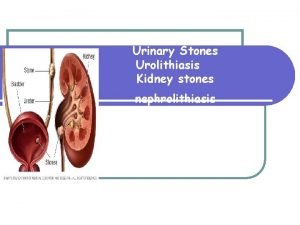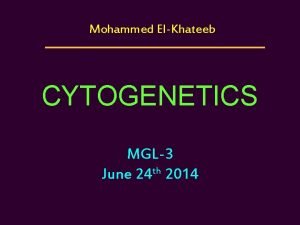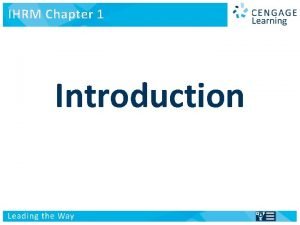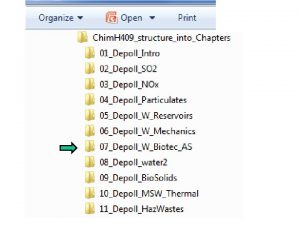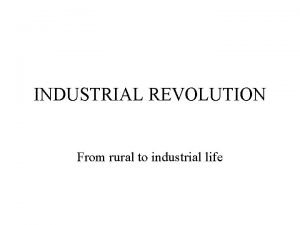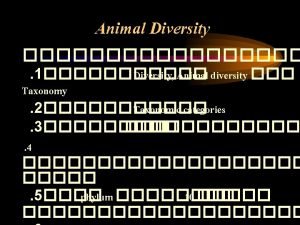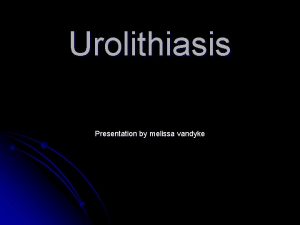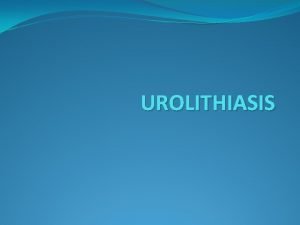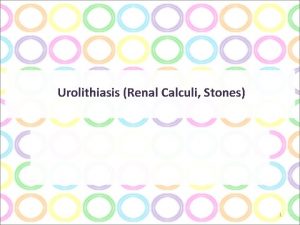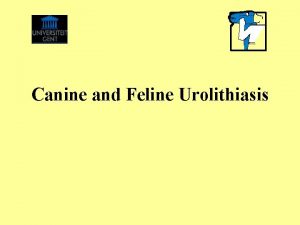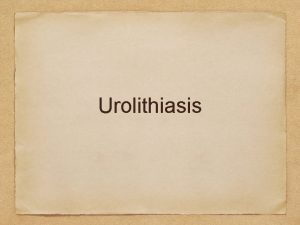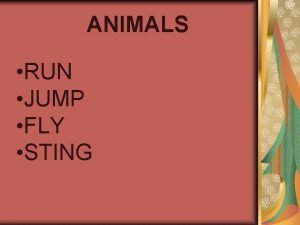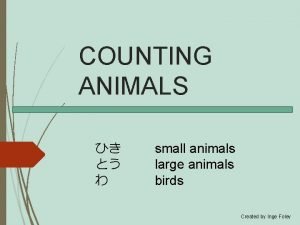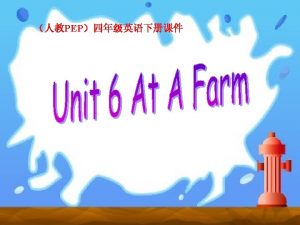Urolithiasis Management of Urolithiasis in Domestic Animals Urolithiasis


























- Slides: 26

Urolithiasis

Management of Urolithiasis in Domestic Animals Urolithiasis- Partial or Complete obstruction in the flow of urine due to presence of calculi in urinary system Mostly commonly affected species– Cattle> Sheep/Goat >Buffalo, Dog Male>Female

Anatomy Of Urinary System & Common Sites Of Obstruction Bovine-Sigmoid flexur Sheep/Goats: Urehral process Dog: Proximal to Ospenis Bovine/Caprine: Post scrotal sigmoid flexure Camel: Pre- scrotal sigmoid flexure

Factors Responsible For Uroliths Formation • Season. Winter-Reduced water intake Summer- Less availability of water, dehydration § Diet-High concentrate/low roughages with large amount of (P) § Low magnesium level-calcium phosphate crystal § High silica containing Grasses -Wheat, oat, barley straw. § Vit. A ↓ -promotes epithelial desquamation act as nidus.

Composition Of Calculi Based On Urine p. H. • Calculi mainly consist salts of Ca, Mg, NH 4 Phosphate, Oxalate and Carbonate. • Acidic urine: -Dog , Cat: Oxalate, Carbonate salt of Ca, Mg, NH 4 • Alkaline urine: Cattle, Buffalo, Sheep/Goat. Phosphate salt of Ca, Mg, NH 4

Composition Of Calculi In Animals • Dog- Struvite (Magnesium Ammonium phosphate), Calcium oxalate, Urate, Cystine, Silicate, Calcium Phosphate. • Horse- Calcium Carbonate • Ox- Struvite, Calcium Oxalate, Silicate, Calcium Phosphate. • Sheep & Goat- Struvite, Calcium Oxalate, Silicate, Calcium Phosphate.

Clinical Sign • Partial obstruction. Uneasiness, Abdominal pain (Colicky), Stranguria, Dribbling urine and haematuria • Complete obstruction. Colic sign-teeth grinding, Rear leg stamping, Circling of tail, Distended urinary bladder ( Rectal palpation) Goat/ Sheep- Frequent bellowing

Diagnosis • Large animals- Rectal palpation Distention of urinary bladder • Small animal- Palpation of belly • Urinalysis-Presence of pus cells, blood cells, and different types of crystal.

Photomicrographs of different types of Urine crystal Calcium Phosphatecolumnar structure Oxalate- envelope-shaped Struvite Calculi- coffin-lid shaped Mixed Crystaluria

Ultrasonography/ Radiography Calculi in Urinary Bladder Distended Urinary Bladder Calculi in urethra proximal to Ospenis

Electrolyte Imbalances • Hyperkalaemia, • Hyperphosphataemia, • Hyponatraemia, • Hypochloraemia • Hypocalcaemia

Within 48 -72 hr- either urethra or bladder ruptured , colic sign disappeared. Urethra ruptured ventral edema Bladder ruptured- Water belly condition Dry and mucous coated dung ball

Prognosis • Severe dehydration, laboured breathing, arched back and protuded rectal mucosa indicate poor prognosis • Cases of nephroliths and atonic bladder have little chances of recovery

Surgical Correction

UROLITH IN BULLOCK RUPTURED URINARY BLADDER

Uroabdomen/Uroperitonium: Accumulation of urine in the peritoneal cavity DRAINING URINE AND URINARY BLADDER REPAIR

Folley’s catheter passed in UB Closure of incision line


URINARY BLADER RUPTUR IN CALF Cystorrhaphy and Tube cystostomy

Management of urolithiasis in goat Amputation of urethral process Amputaion of urethral process

Management of urolithiasis in goat Tube cystostomy


Post-operative care • • • Adequate fluid therapy Analgesic and antibiotic-5 -7 days Indwelling catheter- 2 wks Water should be provided ad lib Ammonium chloride 5 gm bid 15 days

Management of urolithiasis in Dog Urohydropropulsion Verify and localize the urethro-liths with the aid of appropriate imaging procedure(s).

Cystotomy to remove stone from bladder Cystotomy: Incision into urinary bladder Urethrotomy: Incision into urethra

Post operative care • Broad spectrum antibiotic • Antispasmotic • Tab. Cyston for one months
 Struvite vs calcium oxalate
Struvite vs calcium oxalate How to read chromosome
How to read chromosome Https://a-z-animals.com
Https://a-z-animals.com Animals that eat both plants and animals
Animals that eat both plants and animals Parasitic food chain example
Parasitic food chain example Animals that eat both plants and animals
Animals that eat both plants and animals Define international human resource management
Define international human resource management Multinational vs domestic financial management
Multinational vs domestic financial management Horse gives us
Horse gives us Typical composition of untreated domestic wastewater
Typical composition of untreated domestic wastewater Soil conservation and domestic allotment act
Soil conservation and domestic allotment act Domestic system
Domestic system Soil conservation and domestic allotment act
Soil conservation and domestic allotment act John kay invention significance
John kay invention significance Domestic rainwater harvesting
Domestic rainwater harvesting William h taft domestic policy
William h taft domestic policy Domestic marketing strategy
Domestic marketing strategy Maos domestic policies
Maos domestic policies Domestic market extension
Domestic market extension Domestic system
Domestic system Florida coalition against domestic violence
Florida coalition against domestic violence Hitler's domestic policy essay
Hitler's domestic policy essay Introduction to domestic wiring
Introduction to domestic wiring Dwight d eisenhower domestic policy
Dwight d eisenhower domestic policy A sexual reproduction
A sexual reproduction Domestic discipline corner time
Domestic discipline corner time Domestic and family violence protection act 2012
Domestic and family violence protection act 2012
